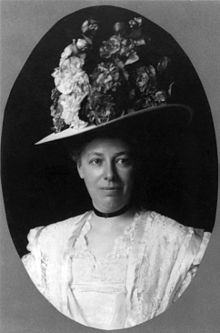Helen Herron Taft | |
|---|---|
 Taft in 1908 | |
| First Lady of the United States | |
| In role March 4, 1909 – March 4, 1913 | |
| President | William Howard Taft |
| Preceded by | Edith Roosevelt |
| Succeeded by | Ellen Axson Wilson |
| Personal details | |
| Born | Helen Louise Herron June 2, 1861 Cincinnati, Ohio, U.S. |
| Died | May 22, 1943 (aged 81) Washington, D.C., U.S. |
| Resting place | Arlington National Cemetery |
| Spouse | |
| Children | |
| Education | University of Cincinnati |
| Signature | |
Helen Louise "Nellie" Taft (née Herron; June 2, 1861 – May 22, 1943) was the First Lady of the United States from 1909 to 1913 as the wife of President William Howard Taft. Born to a politically well-connected Ohio family, she took an early interest in political life, deciding at the age of 17 that she wished to become first lady. Herron married Taft in 1886, and she guided him throughout his political career, encouraging him to take actions that would bring him closer to the presidency. Accompanying her husband to the Philippines in 1900, she became a prominent socialite in Manila, contributing to US-Philippines relations. After her husband was appointed Secretary of War, she played a significant role in convincing him to run for president in the 1908 presidential election and making the necessary connections to ensure his success.
As first lady, Taft was closely involved in the political aspects of the presidency, regularly sitting in on meetings and serving as her husband's closest advisor. She held a strong influence over the president's decisions, expressing her concerns when she disagreed with him and providing her input on presidential appointments. She also carried out a reorganization of the White House staff and decor. Inspired by her experience in the Philippines, she converted the White House lawn and the West Potomac Park into social hubs with regular live shows and events. Her decision to plant cherry trees in the park proved to be a success, creating a popular tourist attraction. Taft's influence as first lady was cut short by a stroke two months into her tenure, permanently limiting her mobility and leaving her absent for a year while she partially recovered.
Though President Taft was relieved that his term had ended, Helen Taft was upset by his defeat for reelection. She remained active after leaving the White House, supporting the Red Cross during World War I and participating in activities for the Colonial Dames of America. She was widowed in 1930, and she was buried beside her husband in Arlington National Cemetery after her death in 1943.